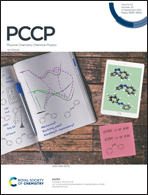Structural stability and evolution of half-metallicity in Ba2CaMoO6: interplay of hole- and electron-doping†
Abstract
Half-metallic ferromagnetic materials have attracted a lot of attention due to their probable technological applications in spintronics. In this respect, doping plays a crucial role in tailoring or controlling the physical properties of the system. Herein, the impact of both hole and electron doping on the structural, electronic and magnetic properties of the recent high pressure synthesized non-magnetic insulator Ba2CaMoO6 double perovskite oxide are investigated by replacing one of the Mo ions with Nb and Tc. The structural and mechanical stability of the undoped/doped materials are analyzed by calculating the formation energies and stiffness tensors, respectively, which confirm the system's stability. Interestingly, our results revealed that Nb- and Tc-doped systems display an electronic transition from insulating to p- and n-type half-metallic ferromagnetic states, respectively. The most striking feature of the present study is that oxygen ions become spin-polarized, with a magnetic moment of ∼0.12 μB per atom, and are mainly responsible for conductivity in the Nb-doped system. However, the admixture of Tc 4d non-degenerate orbitals are primarily contributing to the metallicity in the Tc-doped structure, with a moment of ∼0.59 μB. It is also found that Nb and Tc ions remain in the 5+ and 7+ states with electronic configurations of t22g↑t22g↓e0g↑e0g↓ and t32g↑t22g↓e0g↑e0g↓, with spin states of S = 0 and S = 1/2 in the individual doped systems, respectively. Hence, the present work proposes that a doping strategy with a suitable candidate could be beneficial to tune the physical properties of the materials for their potential utilization in advanced spin-based devices.



 Please wait while we load your content...
Please wait while we load your content...